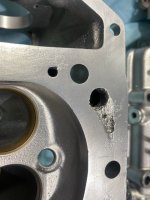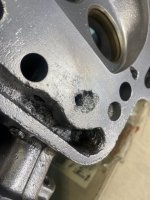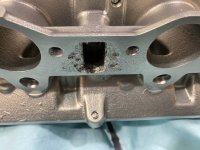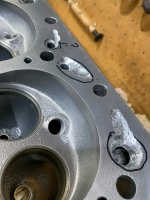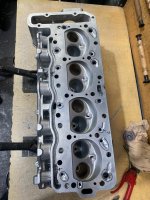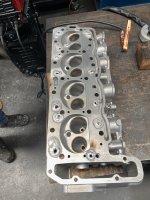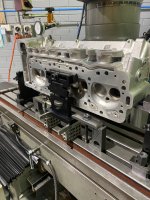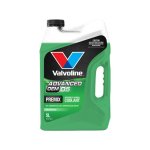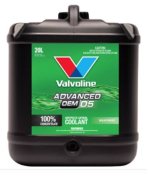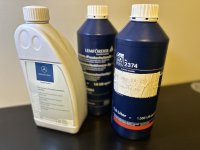Here's the method I've developed to change coolant. It can be adapted to almost any car:
1. Jack up the car (don't forget to drive it on some small timber ramps first, so the trolley jack will fit),
2. Put safely on axle stands,
3. Have a big floor squeegee on hand,
4. Put a large container (or several) under the radiator, expansion tank and back of the engine (otherwise you’re about to make a huge mess!). I intend to cut down a 1000L plastic water tank so it forms a small pool. I've used a kid's wading pool in the past, but it won’t last long if you drag it across the concrete when it's full of water!
5. Remove the radiator cap off (cold only),
6. Drain the radiator via the bottom hose,
7. Disconnect the top hose at the radiator,
8. Disconnect both heater hoses at the back of the engine,
9. Remove the coolant drain plugs from the block (I've never tried on a 6.9L),
10. Remove the containers from under the car,
11. Discard the old coolant into the sewerage (not the storm water),
12. Reposition the containers back under the car,
13. Fit a trigger nozzle to a garden hose,
14. Blast mains pressure water into the expansion tank, radiator top neck and heater hoses until it comes out clean,
15. Alternate between directions through the heater core,
16. Reconnect the bottom hose without the clamp, just enough to hold water (if you push it on too far, it's too hard to remove/refit several times),
17. Refit the block drain plugs only enough to stop water escaping,
18. Rapidly fill the system with water through expansion tank until it runs out the heater hoses and the top neck of the radiator clean,
19. Drop the bottom hose and allow the water to rush out quickly (the large volume of water rushing out will eventually clean the insides nicely),
20. Repeat refill and drain as many times as necessary until the water comes out clean (alternate filling between the expansion tank, heater hoses and radiator top neck),
21. Remove all the full containers from under the car and empty on the lawn,
22. Replace the block drain plugs if badly corroded (clean the threads with a wire wheel if they're just dirty, but still usable),
23. Refit the block drain plugs with new washers (do not over-tighten them),
24. Replace hoses where necessary,
25. Replace all the hose clamps with Wurth Zebras (which won't badly bite into the hoses and cause them to burst when it’s inconvenient),
26. Reconnect all the hoses,
27. Mix 50% distilled water & 50% MB or OEM coolant (don't use generic stuff) into a clean 20L container,
28. Decant some of the coolant mix into a 2L container and using a funnel refill the cooling system to a level half-way between minimum and maximum,
29. Remove the stands and drop the wheels onto the timber ramps,
30. Remove (hopefully) your trolley jack,
31. Drive off the ramps,
32. Drive back onto the RHF ramp only (this will keep the expansion tank as the highest point in the system),
33. Run the engine with the heater on and the radiator cap removed until hot (to remove all air pockets),
34. Refit the radiator cap,
35. Drive off ramp,
36. Test drive a short distance, while keeping an eye on the temperature,
37. Drink beer (or spirits)!!!
You can get away with only disconnecting one heater hose, if you know what you're doing. On a 6.9, you may be lucky to disconnect them at all, due to accessibility problems! However the flush won't be as thorough if you don't disconnect at least one.
This could take half the day, but you won't have the do it for 2 years! In fact, I've heard the coolant can last up to 5 years if mixed with the correct concentration of distilled water.... Job done!!!
1. Jack up the car (don't forget to drive it on some small timber ramps first, so the trolley jack will fit),
2. Put safely on axle stands,
3. Have a big floor squeegee on hand,
4. Put a large container (or several) under the radiator, expansion tank and back of the engine (otherwise you’re about to make a huge mess!). I intend to cut down a 1000L plastic water tank so it forms a small pool. I've used a kid's wading pool in the past, but it won’t last long if you drag it across the concrete when it's full of water!
5. Remove the radiator cap off (cold only),
6. Drain the radiator via the bottom hose,
7. Disconnect the top hose at the radiator,
8. Disconnect both heater hoses at the back of the engine,
9. Remove the coolant drain plugs from the block (I've never tried on a 6.9L),
10. Remove the containers from under the car,
11. Discard the old coolant into the sewerage (not the storm water),
12. Reposition the containers back under the car,
13. Fit a trigger nozzle to a garden hose,
14. Blast mains pressure water into the expansion tank, radiator top neck and heater hoses until it comes out clean,
15. Alternate between directions through the heater core,
16. Reconnect the bottom hose without the clamp, just enough to hold water (if you push it on too far, it's too hard to remove/refit several times),
17. Refit the block drain plugs only enough to stop water escaping,
18. Rapidly fill the system with water through expansion tank until it runs out the heater hoses and the top neck of the radiator clean,
19. Drop the bottom hose and allow the water to rush out quickly (the large volume of water rushing out will eventually clean the insides nicely),
20. Repeat refill and drain as many times as necessary until the water comes out clean (alternate filling between the expansion tank, heater hoses and radiator top neck),
21. Remove all the full containers from under the car and empty on the lawn,
22. Replace the block drain plugs if badly corroded (clean the threads with a wire wheel if they're just dirty, but still usable),
23. Refit the block drain plugs with new washers (do not over-tighten them),
24. Replace hoses where necessary,
25. Replace all the hose clamps with Wurth Zebras (which won't badly bite into the hoses and cause them to burst when it’s inconvenient),
26. Reconnect all the hoses,
27. Mix 50% distilled water & 50% MB or OEM coolant (don't use generic stuff) into a clean 20L container,
28. Decant some of the coolant mix into a 2L container and using a funnel refill the cooling system to a level half-way between minimum and maximum,
29. Remove the stands and drop the wheels onto the timber ramps,
30. Remove (hopefully) your trolley jack,
31. Drive off the ramps,
32. Drive back onto the RHF ramp only (this will keep the expansion tank as the highest point in the system),
33. Run the engine with the heater on and the radiator cap removed until hot (to remove all air pockets),
34. Refit the radiator cap,
35. Drive off ramp,
36. Test drive a short distance, while keeping an eye on the temperature,
37. Drink beer (or spirits)!!!
You can get away with only disconnecting one heater hose, if you know what you're doing. On a 6.9, you may be lucky to disconnect them at all, due to accessibility problems! However the flush won't be as thorough if you don't disconnect at least one.
This could take half the day, but you won't have the do it for 2 years! In fact, I've heard the coolant can last up to 5 years if mixed with the correct concentration of distilled water.... Job done!!!
Last edited:

